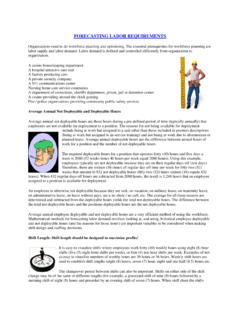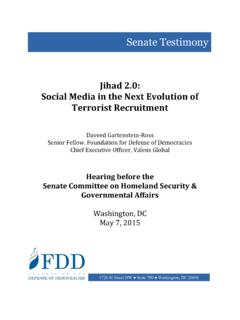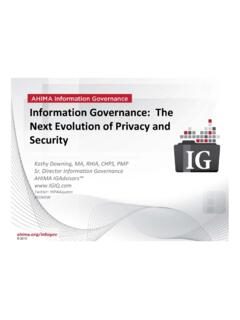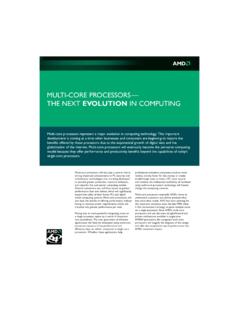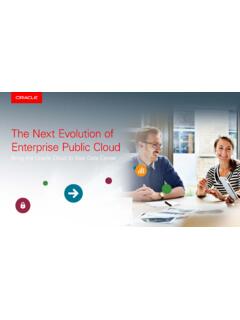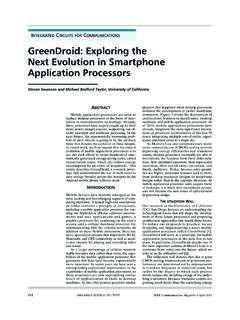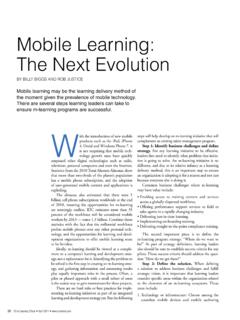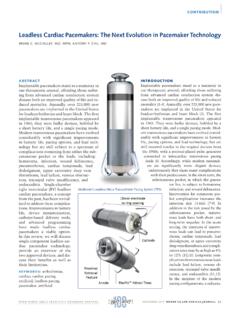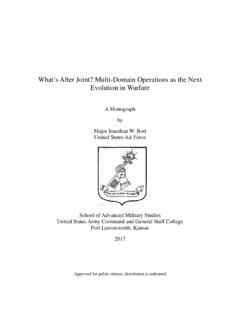Transcription of Total Workforce Optimization: The Next Evolution of ...
1 WHITEPAPER Total Workforce optimization : The next Evolution of Workforce Management Garry E. Meier Strategic Planning Management and Implementation Inc. Right People ~ Right Jobs ~ Right Time 1 Table of Contents Introduction page 2 Proven ROI with Workforce Automation page 3 Shortcomings of Typical Automation Systems pages 3 - 4 Total Workforce optimization : The next Evolution of Workforce Management pages 5 - 6 Key Elements of Total Workforce optimization pages 6 - 9 Requirements for Successful Total Workforce optimization page 10 Benefits of Total Workforce optimization page 11 About SmartTime page 11 Right People ~ Right Jobs ~ Right Time 2 Introduction In today s economy, management has been forced to cut staff levels to an absolute minimum.
2 Organizations are hard-pressed to find new ways to cut costs and drive revenue growth. One of the largest and most critical areas of cost and opportunity is labor or Workforce management. Companies often are caught between the competing pressures of doing more with less while managing the negative impact of decreased satisfaction from over-worked employees. However, when additional headcount is not an option, addressing Workforce efficiency and optimizing labor productivity is critical to the strategic solution. To remain competitive in this lean economy and in the long term, companies must manage labor resources more effectively and have a strategy in place for maintaining maximum operational efficiency over time, regardless of the various Workforce scenarios that may arise. To date, organizations with medium- to large-sized Workforce structures have automated the collection and processing of Workforce data to immediately identify and eliminate inefficiencies (and excess-related costs) associated with paper-based recording, human data entry and the inevitable payroll errors associated with them.
3 These efficiency savings, while significant, represent a fraction of the ultimate business benefits currently derived from traditional Workforce management. The next generation of Workforce management, Total Workforce optimization , will expand beyond familiar cost-savings tactics, providing companies with advanced tools and strategic techniques for Workforce planning, enabling companies to create and implement optimum Workforce structures that maximize cost savings, productivity, and employee satisfaction. This whitepaper outlines and discusses the benefits of standard automation, including an overview of existing Workforce management solutions while providing an introduction to the next -generation strategy, Total Workforce optimization . The paper presents the benefits of and identifies the pre-requisites for successful Total Workforce optimization implementation in today s mid- to large-sized enterprise.
4 Right People ~ Right Jobs ~ Right Time 3 Proven Return on Investment with Workforce Automation Recording, tracking, managing, and reporting time and attendance data of a large, hourly Workforce can be a resource-intensive job involving a large number of staff, a significant amount of daily hours, and other resources, such as paper and postage costs. Today s Workforce automation technology helps companies with large, complex workforces realize rapid and dramatic savings in the following areas. Reduction of timekeeping staff Lower error rates Consolidation of redundant systems Increased payroll reporting accuracy Minimization of retroactive pay processing Elimination of paper process and material costs (paper, postage, handling, storage) Improved accuracy in adhering to complex union pay scales and fewer penalty payments Easier compliance with government regulations, such as Fair Labor Standards Act Automation of accounting for other variables in pay rules, such as geography and benefit structures Shortcomings of Typical Automation Systems While the benefits of Workforce automation are clear, choosing a suitable Workforce automation product and service provider can be challenging.
5 The current range of available automation solutions typically fall into one of three categories: Enterprise Resource Planning (ERP) systems which offer some Workforce automation and management features as an ancillary function to their core capabilities; Employee Relationship Management (ERM) systems which tend to focus more on softer elements such as employee satisfaction, benefits information portals and career development; or Workforce Management (WFM) systems which capture time and attendance data in order to provide payroll systems with accurate information. Right People ~ Right Jobs ~ Right Time 4 ERP ERM WFMWork Force Efficiency Measurable ROI ERP systems successfully achieve measurable ROI on the business processes they automate and enhance, but focus on the Workforce only tangentially to other enterprise resource issues.
6 Conversely, ERM systems tend to emphasize softer elements such as employee satisfaction, which are difficult to monetize. WFM solutions strike the best balance to meet the needs of large, hourly Workforce environments, but even these solutions fall short when it comes to achieving the highest levels of efficiency, flexibility and alignment with overall business goals. Workforce Management systems stand alone in their ability to quickly improve Workforce management efficiency. However, while they clearly enable an organization to implement better practices, they are unable to ensure that they are best practices. The principal shortcoming of WFM lies in its inability to support rapid, continuous improvement and changing scenarios, so companies are insured that they are implementing the best practices for Workforce management. The lack of critical features, such as analysis tools to identify inefficiencies, modeling tools to test new scenarios, flexible rules engines to quickly implement new models, and decision-support functionality to provide real-time and ongoing control make it difficult for organizations to have an iterative improvement process.
7 Without the ability to iterate on labor models, companies cannot strike a balance among Workforce efficiency, improved productivity, and employee satisfaction, while ensuring the implemented model will yield a ROI. Total Workforce optimization offers a more strategic and integrated approach to Workforce management, allowing for continual analysis and improvement across the enterprise. Fig. 1 Workforce Automation Marketscape Right People ~ Right Jobs ~ Right Time 5 ERP Work Force Efficiency Measurable ROI ERM WFM TWO Total Workforce optimization : The next Evolution of WFM While the efficiency opportunity related to automating hourly time reporting is clearly apparent, it only scratches the surface of developing full labor management capability. Paul Hammerman, Giga Information Group Market Overview 2003: Time and Attendance Applications Total Workforce optimization is a business-centric strategy designed by SmartTime Software, Inc.
8 To maximize labor utilization by having the right people on the right jobs, at the right time, and at the right price. It is based on the fundamental concepts of WFM automating the recording and reporting of time and labor while allowing companies to take Workforce management to a new level of productivity and operational efficiency by deploying advanced analytic tools and rules based algorithms to measure and direct an organization through a variety of changing Workforce scenarios. Sophisticated analytic capabilities enable companies to rapidly implement a continuous process for dissecting Workforce data and exploring what-if scenarios through modeling. An integrated system with a dashboard-display of aggregated real-time data allows for operating trends to be monitored and analyzed, ensuring best-practice operating parameters determined from scenario modeling.
9 This real-time analysis equips decision-makers with accurate business intelligence so they can proactively and continually improve Workforce performance and its impact on the overall business. Total Workforce optimization helps companies continually uncover new ways to reduce costs, improve productivity and ensure employee satisfaction through one, integrated approach. As a result, Workforce data transforms into strategic business intelligence that elevates the importance of Workforce management in the enterprise and more closely aligns Workforce management issues with overall business objectives. Fig. 2 Total Workforce optimization , the next Evolution of WFM Right People ~ Right Jobs ~ Right Time 6 For example, a company is faced with the potential purchase of a costly piece of manufacturing machinery: How do they know they will be able to successfully transition to 24/7 productions provided by the machinery and reach a ROI as soon as possible?
10 How will they be able to do this while lowering costs, improving productivity, and ensuring customer satisfaction? In a Total Workforce optimization environment, the Workforce management team can use an integrated approach to compare and contrast what if scenarios through simulation, or modeling. Management can utilize historical and new data to explore the implications a new piece of machinery may have on Workforce issues, such as extensive union negotiations that might result from the equipment investment, including multiple pay-rule scenarios and costly union penalties if the pay-rule scenarios are not followed. With the knowledge gleaned from the Total Workforce optimization approach, decision-makers have a more-informed analysis of the implications of the new piece of machinery and can align this knowledge with other critical factors in the enterprise, such as staffing, productivity, training, and payroll.

